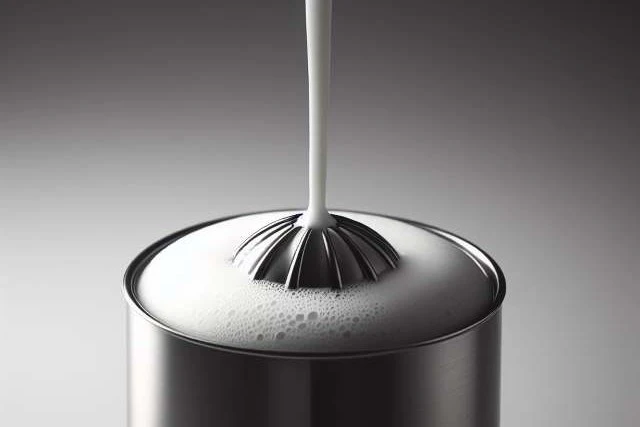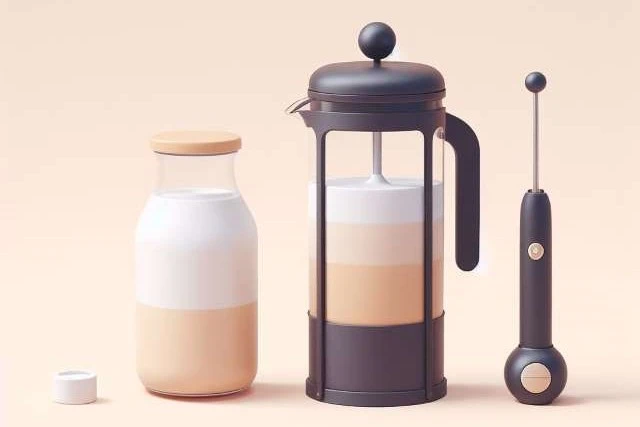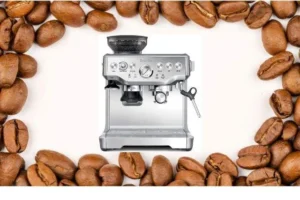Battle of the Brews: Milk Frother vs French Press for Perfect Milk Frothing
The art of milk frothing elevates an ordinary cup of coffee into a luxurious café-worthy creation. With layers of rich, frothy foam floating elegantly atop a base of steamed, creamy milk, a well-frothed beverage is truly a treat for all the senses. But choosing the right frothing tool for your needs can be tricky business in the milk frother vs French press for milk frothing debate. Should you splurge on a high-tech electric milk frother or can a simple French press get the job done just as well?
Milk Frother vs French Press for Milk Frothing Key Takeaways
- Science and Significance: Dive into the intricacies of milk-frothing science and recognize its vital importance.
- Comparing methods: Conduct a detailed analysis of milk frothers and a French press for frothing, unveiling their pros and cons.
- Process and results: Take a close look at the step-by-step frothing processes and comprehensive taste test results for a thorough comparison.
- Practical considerations: Thoughtfully evaluate maintenance, cost factors, and user experiences to make informed decisions for your milk frothing needs.
The Basics of Milk Frothing

Before comparing frothing methods, let’s first understand the science and purpose behind frothed milk.
The Science Behind Frothy Milk
Milk is roughly 87% water and 13% solids, including fat, proteins, and sugars. Heating and aerating milk causes the proteins to denature or “unravel”, allowing them to bond together when cooled. This gives frothed milk a smooth, glossy texture. The more fat in the milk, the creamier the foam.
Why Frothing Matters
Frothing serves several key functions:
- Flavor: Heating brings out the natural sweetness in milk and allows it to blend smoothly.
- Texture: Foam gives drinks a velvety, creamy sensation.
- Appearance: Foam enables pouring latte art.
- Temperature: Frothed milk retains heat better than unheated milk.
Now that we understand why frothy milk is so coveted, let’s examine the two most popular frothing methods.
Meet the Contenders
Both milk frothers and French presses aim to create rich, creamy, well-incorporated foam, but achieve this through different mechanisms.
Exploring Milk Frothers
Milk frothers are appliances designed specifically for frothing liquids. There are two main varieties:
- Electric frothers: These fully automated appliances quickly heat and whip milk at the push of a button. Many feature settings for different types of milk and foam.
- Handheld frothers: Also called whisk frothers, these battery-operated wands must be manually moved through the milk to whip up foam. They do not heat milk.
Unveiling the French Press
The classic French press isn’t just for brewing coffee – it can also be used to froth milk with a bit of skill. This budget-friendly, manual approach harnesses the press’s plunger system to whip air into heated milk.
Now let’s look closer at how milk frothers work and their unique pros and cons.
Milk Frother: In-Depth Analysis

Milk frothers take much of the effort and guesswork out of frothing. But how do they manage to whip milk into a creamy foam so perfectly every time?
How Milk Frothers Work
There are generally three types of milk-frothing mechanisms:
- Steam wands: High-pressure steam is injected into milk to aerate and heat it. Common on espresso machines.
- Whisks or rotors: Milk is drawn through and whipped by high-speed rotors. May also heat milk.
- Magnets: An electromagnet rapidly spins a metal disc, aerating milk placed below. Do not heat milk.
Types of Milk Frothers
The three main mechanisms manifest in several electric and handheld frother varieties:
- Steam wands: Built into high-end espresso machines. Requires skill to operate.
- Whisk frothers: Small appliances with internal whisks. Add air while heating milk.
- Magnetic frothers: Handheld battery-powered wands using electromagnetic discs. Do not heat milk.
Pros and Cons of Milk Frothers
| Pros | Cons |
| Fast and hands-free operation | More expensive than manual frothing |
| Produces thicker, creamier foam | Most only heat small quantities of milk at once |
| Many settings for different foam textures | Equipment must be cleaned after each use |
| Very easy to learn and use | Limited control compared to manual frothing |
French Press: In-Depth Analysis

While milk frothers utilize technology to automatically aerate milk, the French press takes a low-tech, manual approach to frothing.
How French Press Works
A French press uses a simple plunger system to brew coffee, and this same mechanism can be used to froth milk:
- Milk is heated on the stovetop or microwave until hot but not boiling.
- The heated milk is poured into the empty French press.
- The plunger is pumped up and down, drawing air into the milk to create froth.
- The foamed milk is poured into the waiting beverage.
Using French Press for Milk Frothing
The French press isn’t commonly used for frothing, but it can be an affordable, effective option:
- Any standard French press will work. Choose a larger size for frothing more milk.
- The plunger should have a tight fit to incorporate more air into the milk.
- Be careful not to pump too vigorously or milk may spew out the top.
Pros and Cons of French Press
| Pros | Cons |
| Very affordable and cost-effective | Requires manual effort to froth |
| Makes several servings of frothed milk | Produces thinner, less dense foam |
| Heats milk evenly while frothing | Foam separates more quickly than with frothers |
| Total control over foam texture and temperature | Has a learning curve to master technique |
Now that we understand how these two methods work, let’s see them put to the test to crown the ultimate milk-frothing champion.
The Frothing Process: Step By Step

To compare the user experience and foam results side-by-side, we tested each device following standard frothing steps.
Frothing with a Milk Frother
Here is the process for using an electric milk frother:
Preparing the Machine
- Fill the water tank if removable, or fill the frothing pitcher with water to the level indicated.
- Set frothing temperature and foam thickness settings if available.
Frothing Process
- Pour cold milk into the frother pitcher, staying between the min and max fill lines.
- Press the power button to start the automatic frothing cycle. The process takes 1-2 minutes.
- When complete, pour frothed milk out immediately to prevent overheating.
Tips and Tricks
- Always use cold milk – warm milk won’t foam properly.
- Choose full-fat milk for the creamiest, thickest foam.
- Froth extra milk to allow for foam separation.
Frothing with a French Press
Here is how to froth milk using a French press:
Preparing the Press
- Heat milk in a microwave or saucepan until hot but not boiling.
- Place plunger top on press but do not push down.
Frothing Process
- Pour hot milk into the French press. Fill halfway for room to foam.
- Moving the plunger rapidly up and down, pump to draw air into the milk.
- When frothed, plunge several times to help incorporate foam.
Tips and Tricks
- Use a tight-fitting plunger to maximize aeration.
- Plunge faster to make denser foam.
- Don’t fill the press all the way or milk could spill out.
While both methods produced freshly frothed milk, we picked out some noticeable differences in the final results.
Taste Test: Comparing Frothed Milk

To evaluate the merits of frothed milk from each source, we compared four key factors:
The Creaminess Factor
The electric frother-made microfoam with even more velvety texture and mouthfeel. The French press foam was slightly thinner, although still creamy.
Foam Quality
The frother foam was incredibly stable and lasted a while. The French press foam tended to separate faster when sitting.
Flavor Retention
With rapid steaming, the frother preserved more of the fresh, subtle sweetness of the milk. The French press heating diluted the flavor slightly.
Temperature Control
Thanks to temperature sensors, the electric frother heated the milk perfectly with no scalding. The stovetop method for the French press required more attention to avoid overheating.
While the frother definitely produced exceptional quality foam, the French press offered very satisfactory results as well, especially considering the difference in price and manual effort required.
Practical Considerations
Beyond the frothed milk itself, there are other factors that may determine which option best suits your needs.
Maintenance and Cleaning
Frothers require more equipment cleaning than a French press. However, some frothers feature self-cleaning modes to simplify the process.
Cost Comparison
Handheld frothers start around $10-15, while advanced electric frothers cost $50-100+. A standard French press can be purchased for as little as $15-20.
Energy Efficiency
Electric frothers consume power during operation, while the French press has no electrical demand.
Portability
Compact handheld frothers can easily be moved and stored. Full-size electric frothers are less maneuverable. The French press is also highly portable.
User Experience
Examining user reviews provides valuable first-hand accounts of how these devices perform in everyday kitchens.
User Reviews and Insights
- Electric frothers offer consistently excellent results with minimal effort. Most users find them very easy to operate.
- French press users have a slight learning curve, but many love the hands-on experience and getting better with practice.
Common User Mistakes and How to Avoid Them
Milk frothers:
- Not fully assembling/preparing machine before use. Always read instructions first.
- Using milk that is too warm. Always start with cold milk straight from the fridge.
- Overfilling pitcher. Follow fill lines to allow for expansion during frothing.
French press:
- Plunging too vigorously, spilling milk. Use slower, more controlled pressing.
- Overheating milk before frothing. Gently warm milk, don’t let it boil.
- Pressing down the plunger while frothing. Keep the plunger up until ready to plunge after frothing.
With a bit of care, both milk frothers and French presses can produce excellent frothed milk for use in all kinds of hot and cold coffee and tea beverages.
Frothing for Special Diets
The milk frothing method you choose can also depend on your dietary needs or restrictions.
Dairy-Free Options
Many types of dairy-free milk can be frothed, including:
- Soy milk
- Almond milk
- Coconut milk
- Oat milk
Electric frothers in particular can handle dairy-free milks’ trickier textures.
Frothing for Coffee Lovers
Frothed milk is delicious with all types of coffee drinks:
- Lattes
- Cappuccinos
- Macchiatos
- Mochas
- Breves
Frothing for Tea Enthusiasts
Frothy milk also pairs wonderfully with tea, especially:
- Chai tea
- Matcha tea
- Bubble tea
- London fog
No matter your dietary preferences, frothed milk adds flavor and luxury to your favorite hot or cold drink.
The Art of Latte Art

One advantage of manual milk frothing is that it allows you to create dazzling designs on the tops of your drink creations.
Creating Latte Art with a Milk Frother
The consistency and quality of frother foam is excellent for pouring and swirling art. However, the automation means you have less control over the process.
Creating Latte Art with a French Press
Having direct contact with the milk during French press frothing lets you manipulate the foam texture and temperature to allow for detailed etching and pouring.
Conclusion
The milk frother undisputedly rules in terms of quick convenience and luxe results. But the inexpensive French press holds its own for hands-on home baristas seeking control over their brews. Ultimately, the champion for your kitchen depends on your priorities and budget. Either way, with perfectly frothed dairy or dairy-free milk elevating your favorite drinks, you’ll feel like a professional no matter which frothing method you choose!
Milk Frother vs. French Press for Milk Frothing FAQs
Milk frothers automate frothing while French presses require manual pumping. In other words, frothers give less control but the French press lets you adjust texture.
Milk frothers make denser, longer-lasting foam whereas the French press produces thinner foam that separates faster. However, the French press can still froth milk decently.
Milk frothers are easier to use with one-touch operation. Furthermore, most have self-cleaning options, unlike the French press which needs hand washing.
Milk frothers create very consistent, velvety foam perfect for latte art. On the other hand, the French press is harder to make intricate designs with but lets you manually adjust foam.
Yes, both can froth dairy-free milks well, especially electric frothers designed to handle alternatives. Just use barista blends and follow directions for best results.








